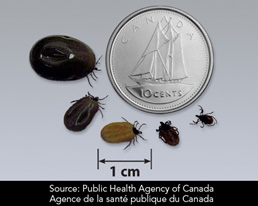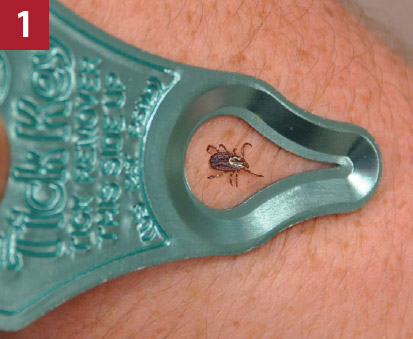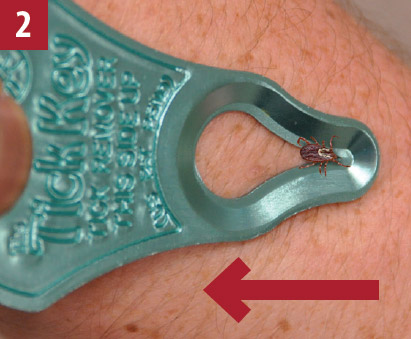Attention: The health unit is no longer accepting ticks for identification or testing through the passive tick surveillance program. Please use the FREE eTick online service.

What are ticks?
Ticks are a relative to the spider and are a crawling, non-flying insect. They vary in size and colour. Ticks are very small (1 to 5 mm) when unfed and female ticks get larger and change colour when feeding.
Do ticks spread disease?
Ticks can spread diseases including Lyme Disease, Rocky Mountain Spotted Fever, Powassan Virus Disease, and Tularemia. Blacklegged ticks (Ixodes scapularis, formerly called deer ticks) spread the bacteria that cause Lyme disease. The bacteria (Borrelia burgdorferi) are most likely to be transmitted after the tick has been attached to you for 24 hours or more. (Government of Canada, 2017).
What is Lyme disease and what are the symptoms of Lyme disease?
Lyme disease is a bacterial infection spread through the bite of a blacklegged tick. South Western Ontario is an established area for Lyme disease, therefore, when going outdoors you and your family members should protect yourselves against ticks.
Early symptoms of Lyme disease usually occur within one to two weeks, but can occur as soon as three days or as long as a month, after being bitten by an infected tick. Symptoms may include:
- fever
- headache
- muscle and joint pains
- fatigue (tiredness)
- skin rash that looks like a red bull’s eye
- numbness or tingling
- swollen lymph nodes (Government of Canada, 2016)
Who is at risk of Lyme disease?
Anyone can get Lyme disease, but people who spend more time outdoors are at higher risk. These include:
- hikers, campers, hunters, or other outdoor enthusiasts
- people who live or work in an area near woods or overgrown bush
- people who have outdoor jobs such as landscaping or brush clearing
Where are blacklegged ticks found?
Ticks are often found in the woods and the edge area between lawns and woods. Ticks can also be carried around by animals into yards, gardens and into houses.
Blacklegged ticks are spreading to new areas of the province because of climate change. Factors like increasing temperatures, rainfall, and humidity can lead to an increase in tick populations. Several times per year, Public Health Inspectors from the WECHU collect ticks from various locations in Windsor and Essex County and send them away for identification and testing for disease. This information is shared with Public Health Ontario and used to create maps showing areas in Ontario where you are more likely to find blacklegged ticks.
Click on the links below for 2018 and 2019 Ontario Lyme disease estimated risk area maps.
Ontario Lyme disease estimated risk areas map, 2018
Ontario Lyme disease estimated risk areas map, 2019
When are blacklegged ticks most active?
Blacklegged ticks go through three life stages: larva, nymph and adult. Exposure to ticks can occur during the months of April to November with the nymphs being active in the late spring and early summer and the adults being active in the fall.
What can I do to protect myself?
- Use insect repellent:
- DEET:
-
Safe when used in correct concentrations, depending on the user’s age. (Government of Canada, 2016)
-
6 months to 2 years: up to 10%, don’t apply more than once a day.
-
2 to 12 years: up to 10% can reapply up to three times daily.
-
12+ years: up to 30%.
NOTE:
Less than 6 months: don’t use DEET products.
Less than 12 years: don’t use DEET daily for more than a month.
-
-
Icaridin:
-
Should not be used on children younger than 6 months old.
-
- DEET:
- Avoid walking in tall grass and stay on the centre of paths.
- Cover up. Wear long- sleeved shirts and pants.
- Wear light coloured clothing to spot ticks easily.
- Tuck your pants into your socks and wear closed toed shoes.
- Do a full body check on yourself, children and pets after being outdoors.
- Shower within 2 hours of being outdoors.
- Put your clothes into a dryer on high heat (at least 60 minutes) to kill any possible ticks
- Put a tick collar on your pets.
- Keep grass in your yard short.
(Ministry of Health and Long Term Care, 2016; Government of Canada, 2016)
What do I do if I’m bitten by a tick?
It’s important to remove the tick as soon as possible. You can remove ticks by using a tick key or a pair of tweezers. Remember: Do not remove a tick with your fingers.
Using a Tick Key:


Using a pair of tweezers:
- Using a pair of tweezers, grasp the tick close to the skin.
- Pull the tick gently outwards and don’t twist (so that mouthparts are not left behind). If it’s not a clean break, try to remove the mouthparts from the skin.
- AVOID squeezing, smothering, burning, or using any other technique to remove the tick.
- Gently wash the bite site with soap and water and then use a disinfectant on the skin. Don’t forget to disinfect the tweezers or the tick key.
If you remove a tick from your body and are concerned about the possibility of Lyme Disease, please follow the steps outlined below:
- Do not dispose of the tick. Keep it in a container or a small plastic bag that can be sealed. Place a piece of damp paper towel in the container or the bag.
- Contact your health care provider and discuss if any further action is required.
Please note that as of January 1, 2020 the Health Unit no longer accepts ticks for identification or testing for tick-borne diseases.
How can I have the tick identified?
If you are interested in having the tick identified, etick.ca is a free online service that uses a photograph of the tick to identify its type.

